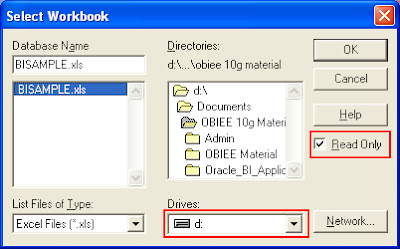First we have to create sample Excel data with ".xls" format. Below is the sample screenshot of three tables which we have created in one excel in three separate tab.

Go to Control Panel -> Administrative Tool -> Data Sources (ODBC) -> Select 'System DSN' Tab. From there click 'Add' Button. We will get 'Create New Data Source' window. From the window select 'Microsoft Excel Driver(*.xls)'
From the above screen Click 'Finish' Button. We will get 'ODBC Microsoft Excel Setup' screen
Click on 'Select
Workbook' button. Now we are in 'Select Workbook' Screen. Here I have
selected the excel file which We have created just before.
If we want to change the data in this excel while 'Oracle BI Servier' is running, we have to uncheck this 'Read Only' option.
So once we have selected the source excel file and setup with the option click 'OK' button with above screen. Give the Data source Name with the below screen and give description (optional) if you want and Click 'OK'
Now we can view the DSN 'BISAMPLE' in System DSN tab in ODBC Data Source Administrator.
Now Open the Administration Tool and go to File -> Import -> Import from Database. Select
'Data Source; Screen will appear. from there leave Connection Type to
'ODBC 3.5' and select BISAMPLE. No UserName and Password is required.
Just Click 'OK'
Once we clicked 'OK' with
the above screen we are coming to import screen. From there select
'System tables' Option. It will show all the tables what we have created
in the separate tab of an excel.
Click 'Import' with the
above screen. Now we can view all the tables in the physical layer of
the rpd. Update the row count to check the data.
All other steps are same
which we are following for all other Data sources. Now we can make
physical diagram all other BMM Layer and Presentation Layer work and can
create some report with answers
Points to Remember:
1. For Demo purpose If you need to create some application, we can go for
this type of data source.
2. For huge number of tables, data sets this methods is not good enough
3. If the data volume is increasing in Day by Day, or Month Wise then do not
follow this method.
4. If you are having static data which will not change for a year or a long
period then go for this type method









No comments:
Post a Comment